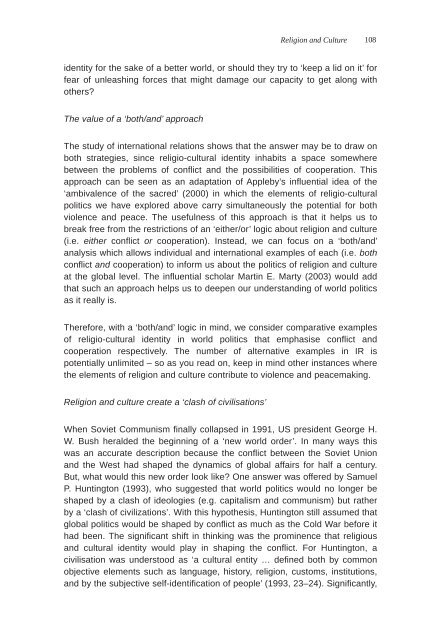International Relations
International-Relations-E-IR
International-Relations-E-IR
You also want an ePaper? Increase the reach of your titles
YUMPU automatically turns print PDFs into web optimized ePapers that Google loves.
Religion and Culture<br />
108<br />
identity for the sake of a better world, or should they try to ‘keep a lid on it’ for<br />
fear of unleashing forces that might damage our capacity to get along with<br />
others?<br />
The value of a ‘both/and’ approach<br />
The study of international relations shows that the answer may be to draw on<br />
both strategies, since religio-cultural identity inhabits a space somewhere<br />
between the problems of conflict and the possibilities of cooperation. This<br />
approach can be seen as an adaptation of Appleby’s influential idea of the<br />
‘ambivalence of the sacred’ (2000) in which the elements of religio-cultural<br />
politics we have explored above carry simultaneously the potential for both<br />
violence and peace. The usefulness of this approach is that it helps us to<br />
break free from the restrictions of an ‘either/or’ logic about religion and culture<br />
(i.e. either conflict or cooperation). Instead, we can focus on a ‘both/and’<br />
analysis which allows individual and international examples of each (i.e. both<br />
conflict and cooperation) to inform us about the politics of religion and culture<br />
at the global level. The influential scholar Martin E. Marty (2003) would add<br />
that such an approach helps us to deepen our understanding of world politics<br />
as it really is.<br />
Therefore, with a ‘both/and’ logic in mind, we consider comparative examples<br />
of religio-cultural identity in world politics that emphasise conflict and<br />
cooperation respectively. The number of alternative examples in IR is<br />
potentially unlimited – so as you read on, keep in mind other instances where<br />
the elements of religion and culture contribute to violence and peacemaking.<br />
Religion and culture create a ‘clash of civilisations’<br />
When Soviet Communism finally collapsed in 1991, US president George H.<br />
W. Bush heralded the beginning of a ‘new world order’. In many ways this<br />
was an accurate description because the conflict between the Soviet Union<br />
and the West had shaped the dynamics of global affairs for half a century.<br />
But, what would this new order look like? One answer was offered by Samuel<br />
P. Huntington (1993), who suggested that world politics would no longer be<br />
shaped by a clash of ideologies (e.g. capitalism and communism) but rather<br />
by a ‘clash of civilizations’. With this hypothesis, Huntington still assumed that<br />
global politics would be shaped by conflict as much as the Cold War before it<br />
had been. The significant shift in thinking was the prominence that religious<br />
and cultural identity would play in shaping the conflict. For Huntington, a<br />
civilisation was understood as ‘a cultural entity … defined both by common<br />
objective elements such as language, history, religion, customs, institutions,<br />
and by the subjective self-identification of people’ (1993, 23–24). Significantly,


